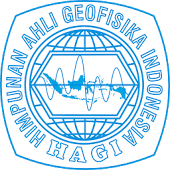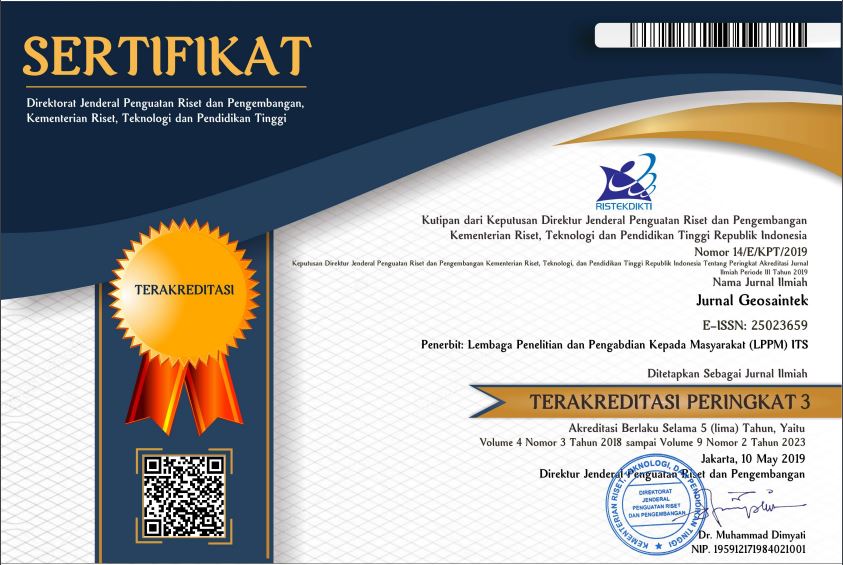UJI KERENTANAN BANGUNAN RUSUNAWA BERDASARKAN HVSR (HORIZONTAL TO SPECTRAL RATIO) DAN FSR (FLOOR SPECTRAL RATIO)
Abstract
Lokasi penelitian terletak di gedung Rusunawa (asrama mahasiswa) yang termasuk ke dalam wilayah administratif Universitas Jambi. Penelitian ini dilakukan untuk mengetahui nilai frekuensi alami tanah (ft), nilai frekuensi alami bangunan (fb), nilai amplitudo (A0), nilai resonansi (%) dan nilai indeks kerentanan bangunan (K) berdasarkan HVSR (Horizontal to Vertikal Spectral Ratio) dan FSR (Floor Spectral Ratio). Secara geologi, gedung Rusunawa berada pada Formasi Muaraenim yang tersusun batupasir tufan dan batulempung tufan, batupasir kuarsa dan batulempung kuarsa, sisipan batubara dan oksida besi. Data penelitian diperoleh dari 36 titik perekaman data mikrotremor. Hasil nilai resonansi pada komponen East – West (EW) dengan rata-rata 330.296%, sedangkan komponen North – South (NS) dengan nilai rata-rata 249.305%. Nilai tersebut memiliki resonansi > 25% dengan klasifikasi rendah berdasarkan klasifikasi kerentanan resonansi. Hasil nilai indeks kerentanan bangunan (K) gedung Rusunawa Universitas Jambi komponen East – West (EW) dengan rata-rata 32.86813 cm/s2, komponen North – South (NS) dengan rata-rata 59.59811 cm/s2 memiliki nilai indeks kerentanan bangunan yang rendah. Nilai indeks kerentanan dibawah dari 1/100 gedung Rusunawa aman terhadap kerusakan.
Keywords
Horizontal to Vertical Spectral Ratio; Floor Spectral Ratio; Resonance; Vulnerability Index, Public Housing
Full Text:
PDFReferences
Aini, D., Utama, W., & Bahri, A. (2012). Penaksiran Resonansi Tanah dan Bangunan Menggunakan Analisis Mikrotremor Wilayah Surabaya Jawa Timur. Jurnal Teknik POMITS, Vol. 1, No. 1, hal. 1-5. http://digilib.its.ac.id/public/ITS-paper-23807-1108100052-Paper.
Bard, P.-Y. (1999). Microtremor measurements: a tool for site effect estimation. The Effects of Surface Geology on Seismic Motion, 3, 1251–1279. https://www.researchgate.net/profile/Pierre-Yves_Bard/publication/235623097_Microtremor_measurements_A_tool_for_site_effect_estimation/links/02e7e53a91aa097773000000/Microtremor-measurements-A-tool-for-site-effect-estimation.
Bemmelen, V. (1949). The Geology of indonesia. martinus Nyhoff. The Haque: Netherland. https://kupdf.net/download/rw-van-bemmelen-geology-of-indonesia-vol-ia-generalpdf_5aa6740be2b6f5772b7b7c58.
BMKG. (2020). Gempa Dirasakan. Badan Meteorologi Klimatologi Geofisika. diambil pada 24 Januari 2022. dari http://www.bmkg.go.id/gempabumi/gempabumi-dirasakan.bmkg.
De Coster, G. L. (1974). The geology of the central and south Sumatra basins. proceeding indonesian petroleum association 3rd annual conversion, june 1974, Jakarta. pp. 77-110. https://pdfcoffee.com/de-coster-the-geology-of-central-and-south-sumatera-basin-pdf-free.
Gosar, A. (2010). Site effects and soil-structure resonance study in the Kobarid basin (NW Slovenia) using microtremors. Natural Hazards and Earth System Sciences, Vol. 10, No. 4, Hal. 761–772. https://nhess.copernicus.org/articles/10/761/2010/nhess-10-761-2010.
Hadianfard, M. A., Rabiee, R., & Sarshad, A. (2017). Assessment of Vulnerability and Dynamic Characteristics of a Historical Building Using Microtremor Measurements. International Journal of Civil Engineering, Vol. 15, No. 2, Hal 175–183. https://doi.org/10.1007/s40999-016-0086-2.
Nakamura, Y. (2000). Clear identification of fundamental idea of Nakamura’s technique and its applications. In Proceedings of the 12th world conference on earthquake engineering. Vol. 2656, pp. 18. https://www.researchgate.net/publication/228603691_Clear_identification_of_fundamental_idea_of_Nakamura's_technique_and_its_applications.
Partono, W. (2015). Aplikasi Metode HVSR pada Perhitungan Faktor Amplifikasi Tanah di Kota Semarang. Media Komunikasi Teknik Sipil, Vol. 19. No. 2, Hal. 125–134. https://doi.org/10.14710/mkts.v19i2.8421.
Putri, H. (2015). Asrama Mahasiswa Universitas Jambi (Kampus Mendalo Darat). Semarang. Universitas Diponegoro. Http://Eprints.Undip.Ac.Id/46048/1/Hertini_Dwi_Ayu_Putri_21020111120010_Asrama_Mahasiswa_Universitas_Jambi_(Kampus_Mendalo_Darat).
PVMBG, 2022. Galeri Pusat Vulkanologi dan Mitigasi Bencana Geologi. diambil 05 Januari 2022. dari https://vsi.esdm.go.id/gallery/picture.php?/220.
Sato, T., Nakamura, Y., & Saita, J. (2008). The change of the dynamic characteristics using microtremor. The 14 Th World Conference on Earthquake Engineering, 12–17. https://www.sdr.co.jp/papers/14wcee/14wcee_microtremor.
Setia, T. N., Afifudin, M., & Idris, Y. (2019). Identifikasi Frekuensi Natural dan Damping Ratio dengan Menggunakan Mikrotremor Gedung Evakuasi Bencana Desa Ulee Lheue dan Desa Lambung. Journal of The Civil Engineering Student, 1(3), 162–168. http://etd.unsyiah.ac.id/index.php?p=show_detail&id=51099.
Setiawan, J. H. (2009). Mikrozonasi Seismisitas Daerah Yogyakarta dan Sekitarnya. Institut Teknologi Bandung, Bandung. https://docplayer.info/63817049-Mikrozonasi-seismisitas-daerah-yogyakarta-dan-sekitarnya-tesis-jb-januar-herry-setiawan-nim.html
Team, S. (2004). Guidelines for the implementation of the H/V spectral ratio technique on ambient vibrations. Measurements, processing and interpretations. WP12 European commission - Research general directorate project no. EVG1-CT-2000-0026 SESAME. pp. 62. https://orbi.uliege.be/bitstream/2268/250698/1/HV_User_Guidelines.
DOI: http://dx.doi.org/10.12962%2Fj25023659.v8i1.12272
Refbacks
- There are currently no refbacks.

Jurnal Geosaintek diterbitkan oleh ITS bekerja sama dengan Himpunan Ahli Geofisika Indonesia (HAGI)
Disebarluaskan di bawah Lisensi Creative Commons Atribusi-BerbagiSerupa 4.0 Internasional.
Berdasarkan ciptaan pada https://iptek.its.ac.id/index.php/geosaintek/index.





